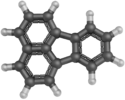Fluoranthène
| Fluoranthène | |
  Structure du fluoranthène. |
|
| Identification | |
|---|---|
| Nom UICPA | Fluoranthène |
| Synonymes |
Benzo[jk]fluorène |
| No CAS | |
| No ECHA | 100.005.376 |
| No CE | 205-912-4 |
| PubChem | |
| SMILES | |
| InChI | |
| Propriétés chimiques | |
| Formule | C16H10 [Isomères] |
| Masse molaire[2] | 202,250 6 ± 0,013 5 g/mol C 95,02 %, H 4,98 %, |
| Susceptibilité magnétique | 138×10-6 cm3·mol-1[1] |
| Propriétés physiques | |
| T° fusion | 110,8 °C |
| T° ébullition | 383,5 °C[3]. |
| Masse volumique | 1 252 kg·m-3 |
| Thermochimie | |
| Cp | |
| Précautions | |
| SGH[6] | |
| H302, H410, P273 et P501 |
|
| Classification du CIRC | |
| Groupe 3 : Inclassable quant à sa cancérogénicité pour l'Homme[5] | |
| Composés apparentés | |
| Isomère(s) | Pyrène |
| Unités du SI et CNTP, sauf indication contraire. | |
| modifier |
|
Le fluoranthène est un hydrocarbure aromatique polycyclique dérivant structurellement d'un naphtalène lié à un benzène par deux liaisons simples formant avec celui-ci un cycle pentagonal. Il s'agit donc d'un HAP dit non alternant, isomère structurel du pyrène, qui est, lui, un HAP alternant ; les électrons π ne sont pas délocalisés dans l'ensemble de la molécule, contrairement au pyrène, qui est, pour cette raison, plus stable que le fluoranthène.
Comme son nom l'indique, il présente une fluorescence induite par les ultraviolets.
Le fluoranthène est un polluant cancérogène inscrit sur la liste des cancérogènes du groupe 3 du CIRC considéré comme l'un des plus nocifs[réf. nécessaire].
Production et synthèse
[modifier | modifier le code]Le fluoranthène est extrait du goudron par distillation[3].
Notes et références
[modifier | modifier le code]- (en) Hyp J. Dauben, Jr., James D. Wilson et John L. Laity, « Diamagnetic Susceptibility Exaltation in Hydrocarbons », Journal of the American Chemical Society, vol. 91, no 8, , p. 1991-1998
- Masse molaire calculée d’après « Atomic weights of the elements 2007 », sur www.chem.qmul.ac.uk.
- (en) Gerd Collin et Hartmut Höke, Tar and Pitch, Wiley-VCH Verlag GmbH & Co, coll. « Ullmann's Encyclopedia of Industrial Chemistry », (DOI 10.1002/14356007.a26_091, présentation en ligne)
- (en) Carl L. Yaws, Handbook of Thermodynamic Diagrams, vol. 3, Huston, Texas, Gulf Pub. Co., (ISBN 0-88415-859-4)
- IARC Working Group on the Evaluation of Carcinogenic Risks to Humans, « Evaluations Globales de la Cancérogénicité pour l'Homme, Groupe 3 : Inclassables quant à leur cancérogénicité pour l'Homme », sur monographs.iarc.fr, CIRC, (consulté le ).
- SIGMA-ALDRICH
Articles connexes
[modifier | modifier le code]Text is available under the CC BY-SA 4.0 license; additional terms may apply.
Images, videos and audio are available under their respective licenses.






